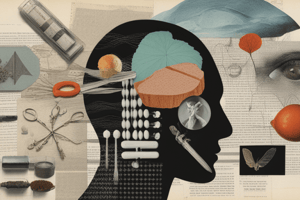Podcast
Questions and Answers
What is the result of the reaction of the ultimate toxicant with the target molecule?
What is the result of the reaction of the ultimate toxicant with the target molecule?
- Activation of the target molecule's function
- Hydrolysis of the target molecule
- Injury to the target molecule, cell organelles, cells, tissue, and organs (correct)
- Stimulation of enzyme reaction
What type of binding occurs between toxicants and receptors, ion channels, or enzymes?
What type of binding occurs between toxicants and receptors, ion channels, or enzymes?
- Covalent binding
- Nucleophilic binding
- Noncovalent binding (correct)
- Electrophilic binding
What is a characteristic of target molecules that allows them to react with toxicants?
What is a characteristic of target molecules that allows them to react with toxicants?
- Lack of reactivity
- Critical function in the cell
- Appropriate reactivity and/or steric configuration (correct)
- Inability to bind to toxicants
How can the ultimate toxicant alter the target molecule?
How can the ultimate toxicant alter the target molecule?
What is necessary to identify a target molecule as responsible for toxicity?
What is necessary to identify a target molecule as responsible for toxicity?
What is a possible effect of toxicants on target molecules?
What is a possible effect of toxicants on target molecules?
What is the result of SH groups interfering with the template function of DNA?
What is the result of SH groups interfering with the template function of DNA?
What is the consequence of xenobiotics interacting with promoter regions of genes?
What is the consequence of xenobiotics interacting with promoter regions of genes?
What is the result of peroxidative degradation of cellular components?
What is the result of peroxidative degradation of cellular components?
What is the consequence of dysregulation of transcription factors?
What is the consequence of dysregulation of transcription factors?
What is the result of sustained rise in Ca2+ levels?
What is the result of sustained rise in Ca2+ levels?
What is the consequence of impaired function of integrated systems?
What is the consequence of impaired function of integrated systems?
What is the function of thioredoxin in protein repair?
What is the function of thioredoxin in protein repair?
What is the result of ATP depletion in a cell?
What is the result of ATP depletion in a cell?
What is the function of DNA photolyase in DNA repair?
What is the function of DNA photolyase in DNA repair?
What is the consequence of necrosis on neighboring cells?
What is the consequence of necrosis on neighboring cells?
What is the effect of cyanide on ATP synthesis?
What is the effect of cyanide on ATP synthesis?
What is the function of glutathione in lipid repair?
What is the function of glutathione in lipid repair?
What is the consequence of Ca2+ accumulation in the cytoplasm?
What is the consequence of Ca2+ accumulation in the cytoplasm?
What is the function of chaperone proteins in protein repair?
What is the function of chaperone proteins in protein repair?
What is the difference between necrosis and apoptosis?
What is the difference between necrosis and apoptosis?
What is the effect of rotenone on ATP synthesis?
What is the effect of rotenone on ATP synthesis?
What is the result of the reaction of hydroxylamine with C in DNA?
What is the result of the reaction of hydroxylamine with C in DNA?
What is the outcome of the reaction of ethyl methanesulfonate with DNA?
What is the outcome of the reaction of ethyl methanesulfonate with DNA?
What is the term for the changes in chromosomal structure, such as breaking off of part of a chromosome or translocation of an arm?
What is the term for the changes in chromosomal structure, such as breaking off of part of a chromosome or translocation of an arm?
What is the term for the uneven separation of chromosomes during cell division?
What is the term for the uneven separation of chromosomes during cell division?
What is the result of sugar-base cleavage by ROS?
What is the result of sugar-base cleavage by ROS?
What is the result of a triplet code being misread entirely?
What is the result of a triplet code being misread entirely?
What is the mechanism of action of base-analog substitution?
What is the mechanism of action of base-analog substitution?
What is the result of the reaction of a genotoxic substance with DNA that involves base substitution?
What is the result of the reaction of a genotoxic substance with DNA that involves base substitution?
What is the most frequently mutated gene in cancer?
What is the most frequently mutated gene in cancer?
What is the term for the type of mutation that involves the addition or deletion of base sequences during DNA replication?
What is the term for the type of mutation that involves the addition or deletion of base sequences during DNA replication?
What is the result of alkylation of the OH group in phosphate?
What is the result of alkylation of the OH group in phosphate?
What is the effect of intercalating agents on DNA?
What is the effect of intercalating agents on DNA?
What is the result of the reaction of UV radiation with DNA?
What is the result of the reaction of UV radiation with DNA?
What is the term for the process of converting an alkyl protein derivative to a hydroxy derivative?
What is the term for the process of converting an alkyl protein derivative to a hydroxy derivative?
What is the effect of HNO2 on DNA bases?
What is the effect of HNO2 on DNA bases?
What is the characteristic of nucleic acids that makes them reactive?
What is the characteristic of nucleic acids that makes them reactive?
What is the result of the reaction of a carcinogen with DNA?
What is the result of the reaction of a carcinogen with DNA?
What is the mechanism of initiation in carcinogenesis?
What is the mechanism of initiation in carcinogenesis?
What is the effect of endocrine disruptors on wildlife?
What is the effect of endocrine disruptors on wildlife?
What is the effect of endocrine disruptors on human health?
What is the effect of endocrine disruptors on human health?
What is the concentration gradient of Ca2+ across the plasma membrane?
What is the concentration gradient of Ca2+ across the plasma membrane?
Why is Ca2+ excluded from the cytosol?
Why is Ca2+ excluded from the cytosol?
What is the result of an increase in cytosolic Ca2+?
What is the result of an increase in cytosolic Ca2+?
What is the primary target for cell damage from ionizing radiation?
What is the primary target for cell damage from ionizing radiation?
What is the result of mitotic death?
What is the result of mitotic death?
What is the function of the electron transport system?
What is the function of the electron transport system?
What is the result of oxidative phosphorylation?
What is the result of oxidative phosphorylation?
What is the function of uncoupling proteins in brown fat?
What is the function of uncoupling proteins in brown fat?
What is the result of oxidative stress?
What is the result of oxidative stress?
What is the result of ROS reacting with proteins?
What is the result of ROS reacting with proteins?
Flashcards are hidden until you start studying




